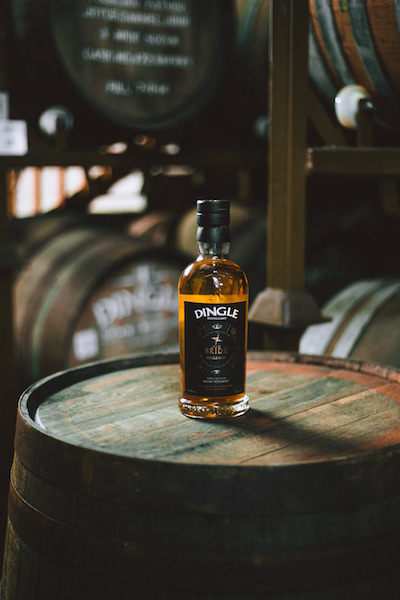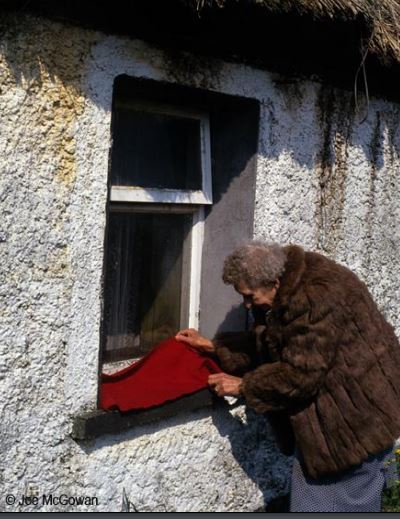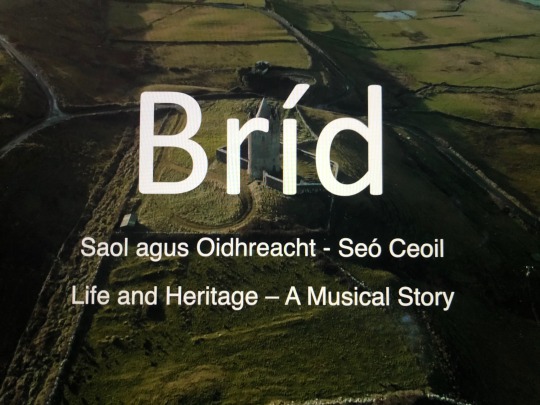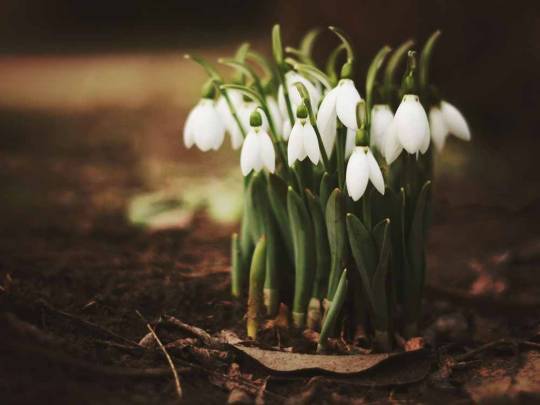#Lá le Bríde
Text
youtube
Lá fhéile Bríde sona daoibh! Tá an tEarrach linn.
#Tús an Earraigh#Imbolc shona!#Lá le Bríde#Imbolg#St. Brigid's Day#Imbolc#Spring#Earrach#Brigid#Irish#Sadbh Kellett#Irish poetry#Irish mythology#Youtube#ireland#lá fhéile bríde#st brigid
2 notes
·
View notes
Text

Oggi in Irlanda ma non solo si festeggia Imbolc o "Lá Fhéile Bríde" - Il giorno di Santa Brigida.
© Wikipedia
Il termine Imbolc in irlandese significa "in grembo", in riferimento alla gravidanza delle pecore, a indicare che in origine si trattava di una festa legata alle pecore da latte. In questo periodo venivano infatti alla luce gli agnellini e le pecore producevano latte. Il latte fresco, il formaggio, il burro e il siero di latte, per non parlare dei pasticci fatti con le code mozzate degli agnelli, costituivano spesso la differenza tra la vita e la morte per le persone anziane e i bambini, durante il gelo pungente di febbraio.
La festività celebrava la luce, che si rifletteva nell'allungamento della durata del giorno, e nella speranza per l'arrivo della primavera. Era tradizione celebrare la festa accendendo lumini e candele.
In epoca cristiana la festa di Imbolc venne equiparata alla Candelora. Poiché la festa pagana era sotto gli auspici della dea Brígit, si trasformò nella ricorrenza di Santa Brigida.
7 notes
·
View notes
Text
DINGLE DISTILLERY RELEASES LIMITED-EDITION LÁ LE BRÍDE SINGLE MALT WHISKEY
DINGLE DISTILLERY RELEASES LIMITED-EDITION LÁ LE BRÍDE SINGLE MALT WHISKEY #dingle #irish #whiskey #news
The second release in Dingle Distillery’s Wheel of the Year series
Dingle Distillery is proud to launch its highly anticipated Dingle Lá le Bríde Single Malt Whiskey, the second release in a series of nine limited-edition whiskeys in its Wheel of the Year series. This new release is available now at DingleDistillery.ie and across off-licenses and stores nationwide.
Marking the beginning…

View On WordPress
0 notes
Text
Na focail / the lyrics (from FlashLyrics.com, English translation in parenthesis):
Gabbaim molta Bríde (I praise Brighid)
Ionmhain í le hÉirinn (Beloved of Ireland)
Ionhain le gach tír í (Beloved of all lands)
Molaímis go léir i (Let us all praise her)
Lóchrann geal na Laighneach
(The bright torch of Linster)
A' soilsiú feadh na tíre (Shining throughout the land)
Cean ar óghaibh Éireann (The pride of all Irish women)
Ceann na mban ar míne
(The pride of women for gentleness)
Tig an geimhreadh dian dubh (Comes the hard dark winter)
A' gearradh lena ghéire (Cutting with it's severity)
Ach ar Lá 'le Bríde (But on St. Brighids Day)
Gar dúinn earrach Éireann (The Irish spring is near to us)
Brighid of the sunrise
Rising in the morning
Rising with the springtime
Greening all the land
See you in the soft cloud
See you in the raindrop
See you in the winds of change
Blowing through the land
You the red eared white cow
Nourishing the people
Nourish now the hunger
Souls longing in our land
Bird that is unfolding
Now the time's upon us
Only have we eyes to see
Your Epiphany
Gabbaim molta Bríde (I praise Brighid)
Ionmhain í le hÉirinn (Beloved of Ireland)
Ionhain le gach tír í (Beloved of all lands)
Molaímis go léir i (Let us all praise her)
#one of my all time favorite songs about Brighid#brìde#brighid#bríd#gaeilge#gaelpol#eithne ní uallacháin#éire#music#brìde shrine#celtic polytheism#gaelic polytheism#ceallaighcreature#Spotify
52 notes
·
View notes
Text
Gabhaim Molta Bríde
Lyrics:
Gabhaim molta Bríghde, iníon í le hÉireann
Iníon le gach tír í, molaimís go léir í.
Lóchrann geal na Laighneach, soils’ ar feadh na tíre
Ceann ar óigheacht Éireann, ceann na mban ar míne.
Tig an Geimhreadh dian dubh, gearra lena géire
Ach ar lá le Bríghde, gar dúinn Earrach Éireann.
Iníon le gach tír í, molaimís go léir í.
Gabhaim molta Bríghde, iníon í le hÉireann
English translation:
I give praise to Brigid, daughter of Ireland
Daughter of all lands, let us praise her.
The bright torch of Leinster, shining across the country
The leader of Ireland’s youth, leader of gentle women.
The house of Winter is dark, cutting with its sharpness
But on Brigid’s Day, Spring in Ireland draws near to us.
I give praise to Brigid, daughter of Ireland
Daughter of all lands, let us praise her.
#gabhaim molta bríde#brighid#goddess#imbolc#gaeilge#I think the way these lyrics are written is an older orthography? my gaeilge is Limited but I think so#celtic pantheon goddesses#goddess blogging#songs and chants#bíi aril duhéedan le láadan bede wo#áine minogue
19 notes
·
View notes
Photo

Brat Bhríde
- Folklore from duchas.ie
'Each year on the eve of St. Brigid my mother makes a Brat Brigid. This is a strip of black cloth about three inches wide and about one foot and a half in length. This strip is hung on the latch of the door to the outside. It is put there on the thirty first of January and left there till next morning. It is then taken off and kept in the house. The Brat Brigid is afterwards put on a person's head if the person has a headache and is also applied to sores and is supposed to help cure these ailments.' Cork
'Do chuireadh na daoine amach an brat seo maidean Lá 'le Bríde. D'fhágaidís amuigh é go dtí an dara lá. Thógaidís isteach an lá san é roimh ghealadh an lae. Do cuirtí i dtaisce é & deirtear go mbíodh léigheas ann ar gach galar.'
An Blascaod.
(Image: Joe McGowan, Sligo Heritage)
https://www.duchas.ie/ga/cbes/4678384/4674400/4683444
https://www.duchas.ie/ga/cbes/4921822/4909279/5182874
#Ancestors Alive!#What is Remembered Lives#Brat Bhride#St Brigid#Cork#Ireland#Folkways#Ancient Ways#Sacred Ways#Healing#Joe McGowan#Sligo Heritage#Photography
11 notes
·
View notes
Text
le Antaine Ó Raifteirí 1784-1835
"Anois teacht an Earraigh
beidh an lá dúl chun shíneadh,
Is tar eis na féil Bríde
ardóigh mé mo sheol.
Go Coillte Mach rachad
ní stopfaidh me choíche
Go seasfaidh mé síos
i lár Chondae Mhaigh Eo."
I gClár Chlainne Mhuiris
A bheas mé an chéad oíche,
Is I mballa taobh thíos de
A thosós mé ag ól
Go Coillte Mách rachad
Go ndéanfad cuairt mhíosa ann
I bhfogas dhá mhíle
Do Bhéal an átha Mhóir.
Fágaim le huacht é
go n-éiríonn mo chroí-se
Mar a éiríonn an ghaoth
nó mar a scaipeann an ceo
Nuair a smaoiním ar Cheara
nó ar Ghaileang taobh thíos de
Ar Sceathach an Mhíle
nó ar phlánaí Mhaigh Eo.
Cill Aodáin an baile
a bhfásann gach ní ann,
Tá sméara is subh craobh ann
is meas de gach sórt,
Is dá mbéinnse i mo sheasamh
i gceartlár mo dhaoine
D'imeodh an aois díom
is bheinn arís óg.
Bíonn cruithneacht is coirce,
fás eorna is lín ann,
Seagal i gcraobh ann,
arán plúir agus feoil,
Lucht déanta poitín
gan licence á dhíol ann,
Móruaisle na tíre ann
ag imirt is ag ól.
Tá cur agus treabhadh
is leasú gan aoileach
Is iomaí sin ní ann
nár labhair me go fóill,
áitheanna is muilte
ag obair gan scíth ann,
Deamhan caint ar phingin cíosa
ná dada dá shórt.
by Frank O'Connor
Now with the springtime
The days will grow longer
And after St. Bride's day'
My sail I'll let go
I put my mind to it,
And I never will linger
Till I find myself back
In the County Mayo.
In Clare of Morris family
I will be the first night
and in the Wall on the side below it
I will begin to drink
to Maghs Woods I shall go
until I shall make a months visit there
two miles close
to the Mouth of the Big Ford.
I swear
that my heart rises up
as the wind rises up
or as the fog lifts
when I think about Ceara
or about Gaileang on the lower side of it
about Sceathach an Mhíle
or about the plains of Mayo.
Cill Liadain is the town
where everything grows
there are blackberries and raspberries there
and every sort of fruit
and were I to be standing
in the center of my people
age would depart from me
and I would be again young.
There is always wheat and oats
growing barley and flax there
rye in branch there
flower-bread and meat
the folks who make moonshine
without a licence selling it there
the pride of the country
playing and drinking.
There is sowing and plowing
and fertilizing without manure
and it’s many the thing there
of which I have not yet spoken
kilns and mills
working without rest there
with hardly any talk about a pennys rent
or about nothing of that sort.
3 notes
·
View notes
Photo

Bríd’ – Saol agus Oidhreacht – Seó Ceoil (Premiere) Beimid beo dé Luain Lá le Bríde, 1ú Feabhra 2021 ag 7.30p.m. Bígí Linn ….Clic Nasc Anseo: https://youtu.be/EwjNBMG9tYU
2 notes
·
View notes
Text
Brat Bhríde
- Folklore from duchas.ie -
'Each year on the eve of St. Brigid my mother makes a Brat Brigid. This is a strip of black cloth about three inches wide and about one foot and a half in length. This strip is hung on the latch of the door to the outside. It is put there on the thirty first of January and left there till next morning. It is then taken off and kept in the house. The Brat Brigid is afterwards put on a person's head if the person has a headache and is also applied to sores and is supposed to help cure these ailments.' Cork
'Do chuireadh na daoine amach an brat seo maidean Lá 'le Bríde. D'fhágaidís amuigh é go dtí an dara lá. Thógaidís isteach an lá san é roimh ghealadh an lae. Do cuirtí i dtaisce é & deirtear go mbíodh léigheas ann ar gach galar.' An Blascaod
6 notes
·
View notes
Text
Imbolc Festivities
Lá Fhéile Bríde Sona Duit!!!
(Law leh BREEJ-uh SUN-uh ditch)
Happy St. Bríd’s Day To You!

Gabhaim molta Bride
Ionmhain í le hÉireann
Ionmhain le gach tír í
Molaimis go léir í
Lóchrann geal na Laighneach
‘Soilsiú feadh na tire
Ceann ar óghaibh Éireann
Ceann na mban ar míne
Tig an gheimhreadh dian dubh
Gearradh lena ghéire
Ach ar Lá ‘le Bríde
Gar dúinn Earrach Éireann
Gabhaim molta Bride
Ionmhain í le hÉireann
Ionmhain le gach tír í
Molaimis go léir í
I praise Brigid
Beloved in Ireland
Beloved in all countries
Let us all praise her
The bright torch of Leinster
Shining throughout the country
The pride of Irish youth
The pride of our gentle women
The house of winter is very dark
Cutting with its sharpness
But on Brigid’s Day
Spring is near to Ireland
– traditional Gaelic song for Bríd
Today is the Feast Day of Saint Bríd! The festival date of Imbolc on February 1 stretches back to the Iron Ages in Ireland, but the ancient context of the festival is relatively enigmatic. It is very likely a celebration of the beginning of the pastoral season as this is when the ewes start to produce milk. However, being one of the four ancient feast days, the 1st of February and the night before are the focus of many supernatural occurrences and ceremonial traditions.
In the last few hundred years these now focus on St. Bríd – who shares a name with a preChristian figure – who is worshipped and petitioned for blessings and favor. This would include a large feast of primarily dairy-based dishes in honor of the new agricultural season, so whip out the butter and cheese!
There are many legends about St. Bríd in Ireland, legends that mix the values of ancient Irish heroes with the pious and monastic values of early Irish Christianity. “Brigit is the perfect example of Irish hospitality: she can (by a miracle) milk her cows three times in one day to provide a meal for visitors; she can outwit a king (in the cause of charity), as well as any pagan hero could have done and with far more charm.” (Hughes)
She is a great leader of women “Indeed St Brigit’s foundation at Kildare was unique in sixth-century Ireland in being a double monastery for both men and women, each group following the same rule and using a common church, with the government of the whole community held jointly by the Abbess and the bishop-abbot.” (Hughes)

One way of celebrating her was to make a doll or Brideog in her image, which was escorted into or around the house in various manners varying village to village. Usually she was laid to rest inside the house, and divination ensued.
“There [in Ireland] the churn staff, not the corn sheaf, is fashioned into the form of a woman, and called 'Brideog,' little Bride. The girls come clad in their best, and the girl who has the prettiest dress gives it to Brideog. An ornament something like a Maltese cross is affixed to the breast of the figure. The ornament is composed of straw, beautifully and artistically interlaced by the deft fingers of the maidens of Bride. It is called 'rionnag Brideog,' the star of little Bride. Pins, needles, bits of stone, bits of straw, and other things are given to Bride as gifts, and food by the mothers.Customs assume the complexion of their surroundings, as fishes, birds, and beasts assimilate the colours of their habitats. The seas of the 'Garbh Chriocha,' Rough Bounds in which the cult of Bride has longest lived, abound in beautiful iridescent shells, and the mountains in bright sparkling stones, and these are utilised to adorn the ikon of Bride. In other districts where the figure of Bride is made, there are no shining shells, no brilliant crystals, and the girls decorate the image with artistically interlaced straw.The older women are also busy on the Eve of Bride, and great preparations are made to celebrate her Day, which is the first day of spring. They make an oblong basket in the shape of a cradle, which they call 'leaba Bride,' the bed of Bride. It is embellished with much care. Then they take a choice sheaf of corn, generally oats, and fashion it into the form of a woman. They deck this ikon with gay ribbons from the loom, sparkling shells from the sea, and bright stones from the hill. All the sunny sheltered valleys around are searched for primroses, daisies, and other flowers that open their eyes in the morning of the year. This lay figure is called Bride, 'dealbh Bride,' the ikon of Bride. When it is dressed and decorated with all the tenderness and loving care the women can lavish upon it, one woman goes to the door of the house, and standing on the step with her hands on the jambs, calls softly into the darkness, 'Tha leaba Bride deiseal,' Bride's bed is ready. To this a ready woman behind replies, 'Thigeadh Bride steach, is e beatha Bride,' Let Bride come in, Bride is welcome. The woman at the door again addresses Bride, 'A Bhride! Bhride thig a stench, tha do leaba deanta. Gleidh an teach dh’an Triana,' Bride! Bride, come thou in, thy bed is made. Preserve the house for the Trinity. The women then place the ikon of Bride with great ceremony in the bed they have so carefully prepared for it. They place a small straight white wand (the bark being peeled off) beside the figure. This wand is variously called 'slatag Bride,' the little rod of Bride, 'slachdan Bride,' the little wand of Bride, and 'barrag Bride,' the birch of Bride. The wand is generally of birch, broom, bramble, white willow, or other sacred wood, 'crossed' or banned wood being carefully avoided. A similar rod was given to the kings of Ireland at their coronation, and to the Lords of the Isles at their instatement. It was straight to typify justice, and white to signify peace and purity--bloodshed was not to be needlessly caused. The women then level the ashes on the hearth, smoothing and dusting them over carefully. Occasionally the ashes, surrounded by a roll of cloth, are placed on a board to safeguard them against disturbance from draughts or other contingencies. In the early morning the family closely scan the ashes. If they find the marks of the wand of Bride they rejoice, but if they find 'long Bride,' the footprint of Bride, their joy is very great, for this is a sign that Bride was present with them during the night, and is favourable to them, and that there is increase in family, in flock, and in field during the coming year. Should there be no marks on the ashes, and no traces of Bride's presence, the family are dejected. It is to them a sign that she is offended, and will not hear their call. To propitiate her and gain her ear the family offer oblations and burn incense. The oblation generally is a cockerel, some say a pullet, buried alive near the junction of three streams, and the incense is burnt on the hearth when the family retire for the night.” (Carmichael - SLOINNTIREACHD BHRIDE)

Another tradition on Imbolc is to create a Cros Bríde or Bríd cross out of reeds that were pulled on the eve of the festival. These grant protection throughout the end of winter and the rest of the year until new crosses are made in their place the following Imbolc.
“But the entire round of the year is liberally sprinkled with days of festival, and if we begin with St. Briget it is not merely because she was Irish-born but because her feast marks the beginning of the pastoral year. The blessed Bridie was a cowherd and is therefore associated with cattle and with such flowers as the dandelion–the Plant of Bride–yielding a milky juice which was believed to nourish the young lambs in spring. St. Briget’s Feast was very popular and many superstitious practices, more or less Christianized, cling to the preparations made on St. Briget’s Eve, the last day of January. On that day rushes are fashioned into protective charms known as Briget’s Crosses, a name which illustrates how the church has won over pagan symbols*, for the ‘crosses’ take the form of either [sun wheels] or lozenges, and comparative evidence suggests that they are magic symbols of suns or eyes...A three legged [sun wheel], presumably an old form, is reserved for use in the byre: its shape may be compared with the Celtic triskele. The lozenge-shaped charms have their counterparts in many parts of the world... Briget’s Crosses are believed to protect the house and the livestock from harm and from fire. No evil spirit could pass the charm, which was therefore hung above the door of the house and byre. The rushes must be pulled, not cut, on St. Briget’s Eve, and care must be taken to fashion the crosses from left to right, with the sun. As a rule they are left in position until replaced the following year, though I have seen byres with many crosses thrust into the underthatch, the decaying accumulation of annual offerings. In Co. Galway similar crosses made of wood or straw were also placed in the rafters at Hallowe’en, and the discovery of a partly burnt rush cross which had been deposited in a megalith in Co. Limerick points to a more general cult of the ‘cross’. A ‘love-knot’ of similar shape, fashioned out of sedge leaves, is known from South Wales.

It was popularly believed that the saint wandered through the countryside on the eve of her feast day. Bread was left on the doorestep, and in some districts it was the custom to prepare a small bed of rushes or birch twigs and place it by the fire so that Bridie might come in and rest. Sometimes the last sheaf of harvest was used for the purpose. In south-western Ireland a doll made of straw–or decorated churn-staff–was carried from house to house by ‘Biddy Boys’, wearing straw masks such as are used by mummers and by strawboys at weddings, and singing songs in honour of the saint. they would solicit gifts and end the day in jollification. The evening was celebrated by a supper of pancakes [bannocks] taken from a plate laid on a rush cross, and as on the other quarter-days prognostications were made. A ribbon or piece of cloth exposed on St. Briget’s Eve became endowed with curative powers. It was believed that no work which involved the turning of a wheel should take place on the saint’s day. The placing of a periwinkle in each corner of the kitchen likewise hints at a remote pre-agricultural origin for the festival,* but it came to be associated with the pastoral promise of spring, of warmth, new grass, lambs and milk. It is said that the saint placed her foot in water on her feast day so that on that day it begins to warm up each year.” (Evans)
*presumptuous
*no it doesn’t
The * above are obviously my notes on the passage, which is valuable but yikes.
It is traditional to observe the weather on the morning of Imbolc to divine the coming seasons. If it is rainy and cold then the winter crone, An Cailleach, will not be able to gather enough fire wood for her to continue her foray in this world, creating the sharp winds and snows of winter. Winter would be shorter, and the following seasons would bring good fortune! However, if it is warm and sunny the firewood supply of An Cailleach will be great, and she will continue her reign over winter for many more weeks until she turns back to stone before Summer. This could also mean sickness and trouble for the household.
Sing the saint a song today, recite her genealogy and tell her stories. Make a cross, or a dollie for her, and eat lots and lots of cheese. Lá Fhéile Bríde Sona Duit!!!
References:
The Golden Age of Early Christianity in Ireland (7th and 8th centuries) by Dr Kathleen Hughes, in The Course of Irish History ed. Moody and Martin.
Irish Folk Ways, by E. Estyn Evans
The Carmina Gadelica Vol.I, by Alexander Carmichael
#Imbolc#la fheile bride#bride#brid#brigid#brigit#brighd#brighde#imbolg#celtic#folklore#irish#ireland#gaelic#scottish#scottland#tradition#february#saint brigit#polytheism#magic#folk magic#an cailleach#history#culture#irish culture
516 notes
·
View notes
Quote
Gabhaim molta Bríde
Ionmhain í le hÉirinn
Ionmhain le gach tír í
Molaimis go léir í.
Lóchrann geal na Laighneach
Ag soilsiú feadh na tíre
Ceann ar óghaibh Éireann
Ceann na mban ar míne.
Tagann an geimhreadh dian dubh
Ag gearradh lena ghéire
Ach ar Lá 'le Bríde
Gar dúinn earrach Éireann.
Gabhaim Molta Bríde, gan ainm.
5 notes
·
View notes
Text
IMBOLC
Farah Leyeli Zeraoui
Circle of Brigid Magic, Circle of Brigid Bright!
Imbolc, Brigantía, Lapercus (nombre dado por los romanos, relacionado con la Lupercalia), Candelaria (países católicos), Oimelag (nombre que le daban los druidas a la festividad de la oveja lactante), Latha Fhèill Brìghde (Escocia), Lá Fhéile Bríde (Irlanda) y Gwyl Ffraed (Gales), son algunos de los nombres que tiene este…
View On WordPress
0 notes
Photo

Bríd’ – Saol agus Oidhreacht – Seó Ceoil (Premiere) Beimid beo dé Luain Lá le Bríde, 1ú Feabhra 2021 ag 7.30p.m. Bígí Linn ….Clic Nasc Anseo: youtu.be/EwjNBMG9tYU #gaeilge @sdccarts @creativeirl @araschronain https://www.instagram.com/p/CKwd72qHbwV/?igshid=pprozzy27jyd
0 notes
Photo

Bríd’ – Saol agus Oidhreacht – Seó Ceoil (Premiere) Beimid beo dé Luain Lá le Bríde, 1ú Feabhra 2021 ag 7.30p.m. Bígí Linn ….Clic Nasc Anseo: youtu.be/EwjNBMG9tYU #gaeilge @sdccarts @creativeirl @araschronain https://www.instagram.com/p/CKwdBk4n8NV/?igshid=1j5e94rfcm4s0
0 notes